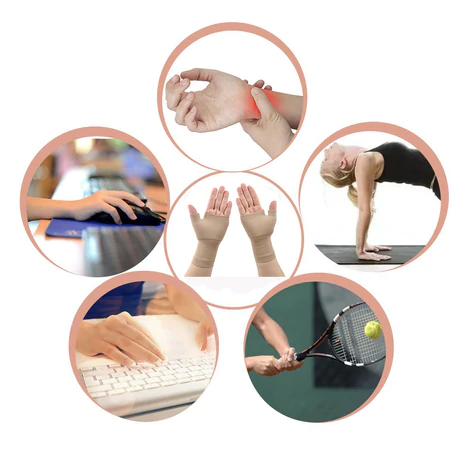
How to Treat Carpal Tunnel Syndrome Without Surgery
Share
Many people want to avoid surgery for carpal tunnel syndrome, and this article is for your reference.
Three Processes Against Carpal Tunnel Syndrome
As a disclaimer, patients with severe carpal tunnel syndrome should be evaluated promptly and treatment has to be delayed as necessary. Persistent hand numbness and loss of muscle mass at the base of the thumb are signs of nerve damage and severe CTS. Surgery is the best way to prevent irreversible damage to nerves. Some hand numbness may be permanent if people wait too long before surgery.
Also, not all hand pain, numbness, and tingling are caused by CTS. Seek early evaluation by a hand specialist or family doctor if symptoms are progressive, severe, or unresponsive to treatment. The following recommendations are for patients with mild to moderate CTS symptoms or who wish to prevent symptom onset in the first place. There are some things you can't change about your health, such as family history, age, and anatomy, but you can change a lot.
In addition to carpal tunnel syndrome surgery, there are other ways that can help.
-
Wear a wristband at night
- stretch your hands and wrists during the day
- Increase physical activity and exercise
- If your weight is unhealthy, consider losing weight
- change hand movements
- Learn healthy computer habits
- stop using cigarettes
- Consider getting a cortisone injection from your doctor
Treatments that don't help with CTS:
- Magnetic therapy
- Laser Treatment
- Long-term use of oral NSAIDs
- Expensive custom stand

Below is some background information on carpal tunnel anatomy. This will help you understand what's going on. The nerve that provides most of the sensation to the hand is called the median nerve. The median nerve allows you to feel parts of your thumb, index, middle, and ring fingers. This nerve passes through the carpal tunnel on the palmar side of the wrist. The carpal tunnel is a narrow, oval space made up of the carpal bones of the wrist and the strong ligaments of the palm. The tendons that move the thumb and fingers also pass through the carpal tunnel. Each finger has two tendons, and the thumb has one. The carpal tunnel has nine tendons and the median nerve. In addition to providing maximum feeling
The carpal tunnel is naturally a small space and the median nerve is at risk of being compressed in this area. Nerves are fragile and I don't like being squeezed. When the nerves are pinched, patients often experience numbness, tingling, needles, electric shocks, and weakness. The sensation in the little finger is caused by another nerve. Therefore, people with CTS usually do not experience numbness in their fingers. Symptoms usually worsen at night. Additionally, the pain can spread to the arm, waking the patient from sleep.
Wear a carpal tunnel splint at night
Most people, myself included, sleep with their wrists bent. If the wrist is not straight, the pressure in the carpal tunnel will increase. Therefore, if you bend your wrist for a long time, such as while sleeping, your nerves may be compressed. This can cause symptoms at night. The easiest remedy is to use a commercially available wrist brace to keep your wrist straight, and train your wrist not to bend it during sleep. Otherwise, you'll have to wake up with numbness or tingling in your hands, reposition your arms and shake your numbness to regain your senses.
How Compression Gloves Help Carpal Tunnel Syndrome
stretch hands and wrists
A physical therapist, occupational therapist, or certified hand therapist can teach you exercises that you can learn to do yourself. Nerve and tendon gliding exercises have been shown to help treat carpal tunnel syndrome. A simple exercise that I find useful is to stretch your fingers and wrists, pull them back, hold for 20 seconds, then relax. Repeat 2-3 times a day for up to 5 minutes each. This stretch should not be painful or excessive. A therapist may also perform ultrasound therapy and iontophoresis to help relieve symptoms.
Physical activity and exercise
Several studies have shown that carpal tunnel symptoms decrease when patients engage in an exercise program, especially vigorous physical activity. Jogging, swimming, exercising, biking or even walking around the neighborhood are great physical activities for you and your carpal tunnel!
lose weight
Obesity or a high body mass index (BMI) has been shown to be an important risk factor for carpal tunnel syndrome. You can reduce this risk by losing weight. Losing weight isn't always easy, so working with a nutritionist or exercise trainer may help.
reduce or quit smoking
Nicotine is an addictive chemical found in tobacco products. It also constricts arteries and reduces blood flow in the body. Reduced blood flow to the hand can make nerves more susceptible to damage. Quitting smoking may reduce risk of CTS symptoms










